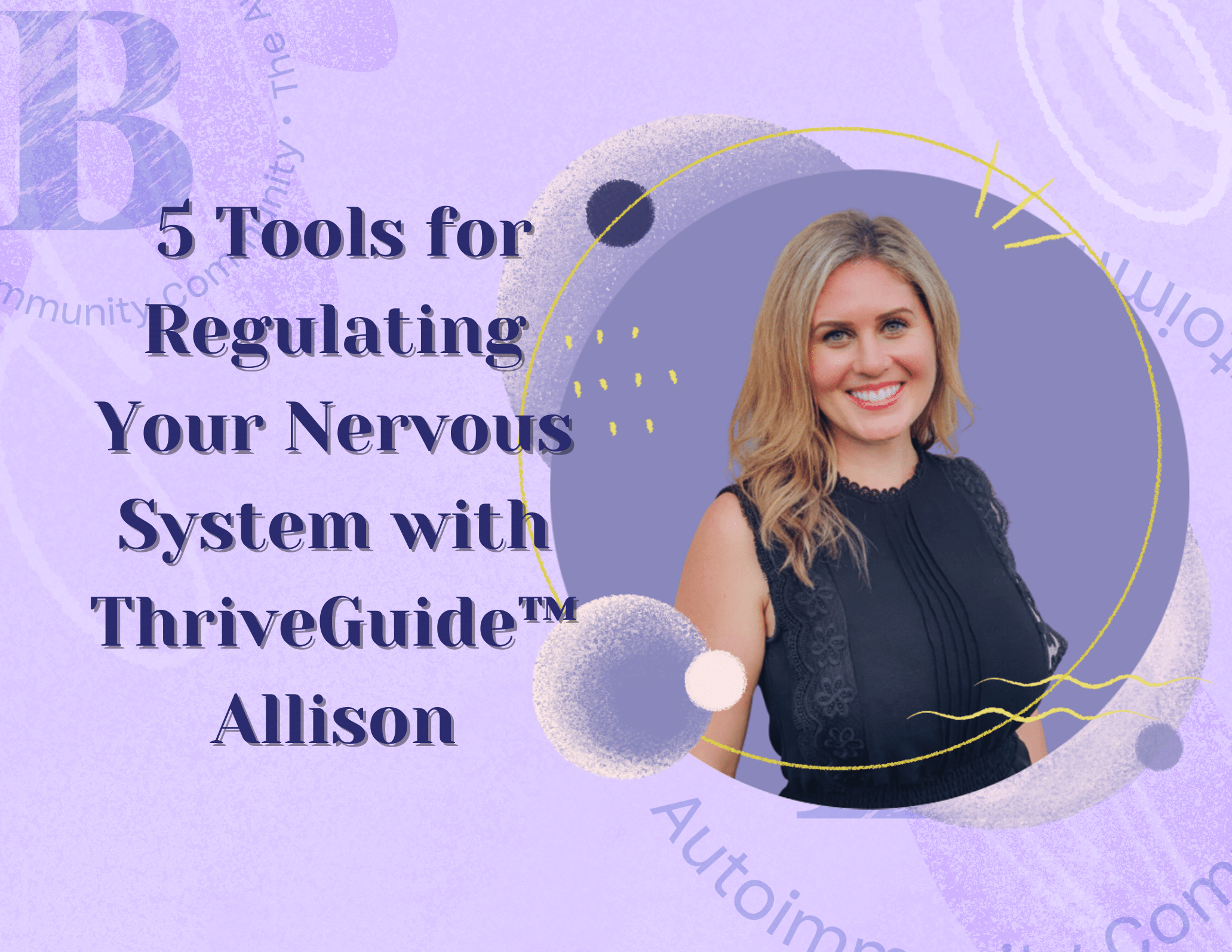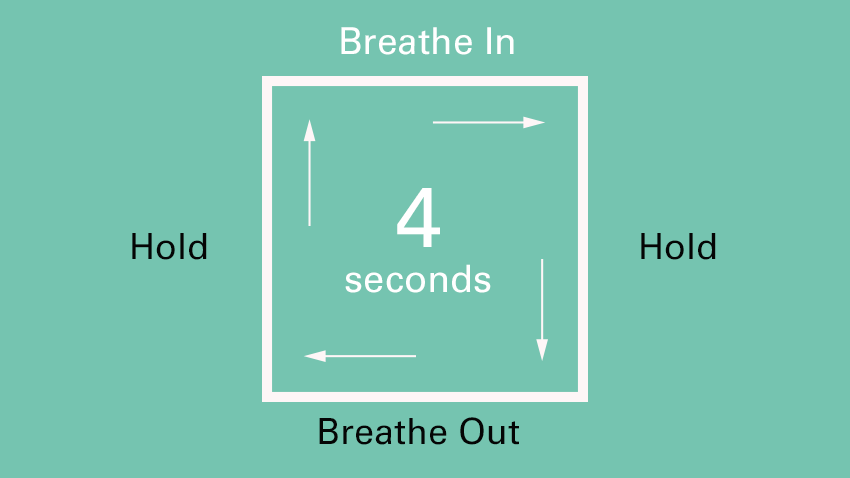
5 Tools for Regulating Your Nervous System
ThriveGuide™ and Certified Holistic Health Coach Allison Rassp specializes in supporting women with Hashimoto’s Disease. Allison has successfully reversed 90% of her own Hashimoto’s symptoms multiple times. Her passion lies in educating, empowering, and supporting others to do the same. With expertise in detoxification, trauma, and regulating the nervous system, Allison emphasizes the importance of both physical and emotional detoxification for overall health.
Have you ever felt like your inner world was a high-speed train, zipping through stations of stress, anxiety, and the all-too-familiar hustle and bustle of daily life? In this “always-on” society, our nervous systems are often working overtime, leaving us feeling as frazzled as squirrels in a nut factory. But what if we told you there’s a way to apply the brakes, to slow down that inner express, and enjoy the scenery of a calmer life??

Can’t believe it? Follow along to gain practical tips and hacks to regulate your nervous system!
Today, we’re diving into the timeless art of tranquility with “5 Tools for Regulating Your Nervous System.” These aren’t just quick fixes or seasonal gimmicks; they’re strategies that have withstood the test of time, much like the sturdy oaks in an ancient forest. Whether you’re reading this while sipping a summer lemonade or curled up with a winter hot tea, these tools are your year-round allies in creating a serene inner landscape through your autoimmune journey.
1. Breathwork Bonanza
Imagine your body’s like your smartphone, and your breath is the charger. When you’re running on 1% because life’s been throwing lemons at you, a good ol’ breathing session for regulating your nervous system can juice you right back up to 100%.
 So, what’s the deal with breathwork and your nervous system? Picture this: your nervous system has two gears. One gear is for when you’re dodging life’s curveballs—that’s the gas pedal or the “sympathetic” gear. The other is when you’re chilling out, maxing, relaxing all cool—that’s the brake or the “parasympathetic” gear. Too much gas and you’re a hot mess; too much brake and you’re a couch potato.
So, what’s the deal with breathwork and your nervous system? Picture this: your nervous system has two gears. One gear is for when you’re dodging life’s curveballs—that’s the gas pedal or the “sympathetic” gear. The other is when you’re chilling out, maxing, relaxing all cool—that’s the brake or the “parasympathetic” gear. Too much gas and you’re a hot mess; too much brake and you’re a couch potato.
Breathwork is like being the world’s best DJ, mixing the perfect track for your body. Deep breaths tell your body to kick back, relax, and drop the stress. Regulating your nervous system this way is like turning down the volume on the crazy, loud world and cueing up your chill playlist.
Sounds great (right?) but wait ‘til you hear about all the other benefits breathwork offers, and the best thing about it is that it’s free, accessible, and easy to do!
- Reduced stress and anxiety: When you’re stressed, your body goes into fight-or-flight mode, releasing stress hormones like cortisol. Breathwork helps activate the parasympathetic nervous system, which promotes relaxation and counteracts the effects of stress hormones.
- Improved sleep: Deep, slow breathing signals to your body that it’s time to wind down, preparing you for a better night’s sleep. Breathwork can also help reduce anxiety and racing thoughts, which can often interfere with sleep.
- Enhanced focus and concentration: By focusing on your breath, you can quiet your mind and improve your ability to concentrate. This can be helpful for anything from studying and working to performing at your best in sports or other activities.
- Increased energy levels: Deep breathing helps bring more oxygen into your body and cells, which can boost your energy levels and combat fatigue.
- Improved emotional regulation: Breathwork can help you become more aware of your emotions and better able to manage them in a healthy way. By focusing on your breath, you can create a space between yourself and your emotions, allowing you to respond rather than react.
- Boosted immune system: Some studies suggest that regular breathwork practice can help strengthen your immune system, making you less susceptible to illness.
- Reduced pain: Breathwork can help distract you from pain and activate the body’s relaxation response, which can help to reduce pain perception.
Ready to explore the power of breathwork? Here are some techniques to get you started.
- The 4-7-8 Technique: Breathe in for 4 counts, hold that precious air for 7, then let it out slow and steady for 8 counts. It’s like giving your body a mini spa session. Here’s a visual guide you can use instead of keeping a mental count:
This practice helps to release anxiety and bring your nervous system back into balance while instilling a sense of presence if we are feeling particularly dysregulated.
- Box Breathing: Picture a square. Inhale for 4 counts, hold for 4, exhale for 4, and hold again for 4. It’s like giving your mind a little square of calm in the middle of chaos. Follow along the visual guide below for practice:
- Belly Breathing: This one’s all about making your belly rise and fall like you’re snoozing on a calm beach. You’ll feel more relaxed than a cat in a sunbeam.
- Alternate Nostril Breathing: This might make you feel like you’re prepping for a magic trick, but it’s legit. Block one nostril, breathe in, swap, and breathe out the other. It’s like a seesaw for your breath that balances you out.
In essence, breathwork is more than just a practice for relaxation; it’s a vital component of managing autoimmune diseases. It empowers individuals to take an active role in their health, using the simple, yet profound, power of breath to foster healing, resilience, and balance.
2. Tapping into Calm: EFT
Imagine your nervous system is like a complex highway system within you, bustling with traffic – thoughts, emotions, and sensory experiences zooming about. Now, picture a traffic jam in this system; that’s what stress feels like in your body. Enter the Emotional Freedom Technique (EFT), akin to a skillful traffic officer, guiding the flow and easing the congestion, regulating the nervous system.
EFT, often referred to as tapping, operates on the premise that emotional distress is intertwined with the physical disruptions of the body’s energy system. This technique is rooted in the principles of ancient Chinese acupressure and the power of mindset, marrying the two to create a simple, yet effective self-help method that anyone can use.
Benefits:
- Stress Reduction: Like flipping a switch, EFT can reduce the body’s stress response, calming your internal alarm system.
- Emotional Healing: It can help process past traumas without the person having to relive the distressing event.
- Pain Management: EFT can contribute to pain relief, potentially lowering the intensity of chronic pain.
- Improvement in Well-being: Regular tapping can lead to increased energy levels and overall well-being.
Step-by-Step Guide to EFT:
- Identify Your Issue: Start by pinpointing the specific problem you want to address. This could be a feeling of anxiety, a physical pain, or a recurring negative thought.
- Test Your Emotional Discomfort Level: Rate the intensity of your issue on a scale from 0-10, where 10 is the highest level of discomfort.
- The Setup: Craft a setup statement that acknowledges the problem and affirms self-acceptance despite it. For example, “Even though I have this anxiety, I deeply and completely accept myself.”
The Tapping Sequence: Perform this tapping sequence two or three times.
- Karate Chop Point: Begin by tapping on the karate chop point of your hand (the fleshy part on the side of your hand below the pinky) while repeating your setup statement three times.
- Tapping Points: Move through the following points, tapping gently 5-7 times on each while repeating a reminder phrase, like “this anxiety.”
- The eyebrow point (just above and to one side of the nose)
- The side of the eye (on the bone bordering the outside corner of the eye)
- Under the eye (on the bone under an inch below your pupil)
- Under the nose (between the bottom of your nose and the top of your upper lip)
- The chin point (midway between the point of your chin and the bottom of your lower lip)
- The collarbone point (just below the hard ridge of your collarbones)
- Under the arm (about a hand’s width from your armpit)
- Top of the head (center of the top of your head)
- Focus on the Feeling: While you’re tapping, focus on the issue at hand. Allow yourself to feel the emotions or physical sensations that come up.
- Re-evaluate Your Intensity: After completing the rounds of tapping, rate the intensity level of your issue again. If it’s still higher than a 2, repeat the process until the intensity decreases.
 EFT is like whispering calming instructions to the traffic controller of your nervous system. It’s not just about tapping away the stress; it’s about acknowledging it, facing it, and then actively deciding to let your body and mind release it. The beauty of EFT lies in its simplicity and the power it gives you to regain control over the highways of your nervous system, allowing for a smoother journey through life.
EFT is like whispering calming instructions to the traffic controller of your nervous system. It’s not just about tapping away the stress; it’s about acknowledging it, facing it, and then actively deciding to let your body and mind release it. The beauty of EFT lies in its simplicity and the power it gives you to regain control over the highways of your nervous system, allowing for a smoother journey through life.
Experimentation with the suggested tools is crucial as each person’s body resonates differently. Some days, your body might prefer one tool over another. Therefore, it’s essential to check in with your body and find out what works best for you. Integrating these tools into your daily routine can help your nervous system maintain its stability.
3. Grounding: Getting Back to Earth
Grounding, also known as earthing, is like sending your overworked nervous system on a spa retreat without leaving your backyard. It’s a technique that involves direct skin contact with the surface of the Earth, such as walking barefoot on grass, soil, or sand. Picture it like this: your body is a battery that sometimes gets too charged up with the static electricity of life’s demands. Grounding helps to discharge this excess energy and reset your system back to its natural state.
Your body is full of electrical currents that power everything from your thoughts to your heartbeats. The Earth is like a giant battery that maintains a negative charge with an endless supply of electrons. When you make direct contact with the ground, these electrons flow into your body, which is believed to promote physiological changes and improvements in well-being.
Grounding can bring our bodies back to nature, reducing anxiety and lowering cortisol levels, our body’s stress hormone. It’s a practical tool that can be incorporated almost anywhere, or even at home. While prime practice is in natural settings, any contact of bare feet with the floor enhances grounding and aids in regulating the nervous system.
One way I integrate grounding in my life is by expressing gratitude each morning when I get out of bed and my feet touch the floor. This simple act of gratitude is also a grounding technique.
The Benefits Are Downright Groundbreaking:
- Reduces inflammation by neutralizing free radicals.
- Improves sleep by normalizing your day-night circadian rhythm.
- Decreases stress levels by reducing cortisol, the stress hormone.
- Increases energy by improving blood flow and oxygenation.
- Calms the nervous system, promoting a sense of peace and well-being.

Step-by-Step Guide to Grounding:
- Find Your Spot: Look for a slice of nature like a park, your backyard, or even a quiet sidewalk with some exposed earth or grass.
- Go Barefoot: Kick off those shoes and socks. Let your feet breathe and prepare to meet Mother Earth.
- Make Contact: Step onto the natural surface. Feel the texture of the Earth beneath your feet – cool grass, warm sand, or the gritty texture of soil.
- Stand or Walk: You can either stand still, walk, or even sit on the ground. The key is to have as much skin contact as possible.
- Breathe Deeply: Close your eyes if you’re comfortable, take deep breaths, and let the rhythm of your breathing help you focus on the sensation of the ground beneath you.
- Soak It In: Aim for at least 15-20 minutes like this. Imagine the Earth’s energy as a green glow that’s entering your body with every breath and neutralizing the chaotic noise of your overactive nervous system.
- Reflect: Once you’re done, take a moment to reflect on any changes in your body. Do you feel more relaxed? Is your mind clearer?
- Repeat: Try to make grounding a regular part of your routine. Much like watering a plant, consistency is key.
 Grounding is a classic example of an ancient practice supported by modern science. It’s a testament to how sometimes the simplest methods – those that involve returning to the basics of nature – can be the most powerful. So next time you’re feeling like your inner circuits are fizzling, go ahead and plant your feet firmly on the ground. It’s free, it’s easy, and it might just be the reboot your system needs by simply regulating the nervous system.
Grounding is a classic example of an ancient practice supported by modern science. It’s a testament to how sometimes the simplest methods – those that involve returning to the basics of nature – can be the most powerful. So next time you’re feeling like your inner circuits are fizzling, go ahead and plant your feet firmly on the ground. It’s free, it’s easy, and it might just be the reboot your system needs by simply regulating the nervous system.
4. Emotion Code: Unlocking Well-being

Dr. Nelson’s Emotion Code is a technique used to get rid of emotional baggage that may be affecting your nervous system. Think of your nervous system as the body’s wiring; sometimes it can carry the leftover energy from strong emotions, like stress or anger, which can mess with your well-being. Should you wish to dive deeper into this resource for regulating your nervous system, you may learn more about it and Dr. Nelson’s work through this blog.
Here are the benefits of using the Emotion Code:
- It helps sort out emotional clutter which can reduce feelings of anxiety and depression and can also help with physical pain that doesn’t seem to have a clear cause.
- It’s like hitting the reset button on your nervous system, helping you feel more centered and less stuck.
To use the Emotion Code, follow these steps:
- Find the problem: Figure out what trapped emotion you’re dealing with. It could be something from a past experience that’s still bothering you.
- Use muscle testing: This is a technique where you test your muscle’s strength or weakness to get yes or no answers from your body. It’s a way to ask your body which emotions are causing issues.
- Look at the Emotion Chart: Nelson’s chart lists many possible emotions that might be trapped. Use it to identify what you’re dealing with.
- Use a magnet or your fingers: Run a magnet or your fingers over your head along the path of the governing meridian, which is an energy line. This action is meant to release the trapped emotion, similar to deleting a file from your computer.
- Repeat and check: Do this three times and use muscle testing to see if the emotion is gone. If your muscle response is strong, you’ve likely released it.
Identifying and acknowledging emotions buried in different parts of our body, like the liver, stomach, and heart is the first step. Emotional release mitigates autoimmune symptoms and uplifts the state of our nervous system.
5. Bilateral Movement: The Body’s Dance of Calm
Imagine your brain as a team of two, where each player has a different skill set but they need to work together to score that touchdown. That’s a bit like how bilateral movement works with our nervous system. “Bilateral” means “two sides” – and when it comes to movement, it’s about getting both sides of your body and, by extension, your brain, to engage in a coordinated dance.
 Now, why is this important? Engaging in activities that promote bilateral movement—such as walking, swimming, or even certain types of dance—can help bridge the gap between the right and left hemispheres of the brain. This synchronicity fosters a sense of mental balance, reducing stress and promoting emotional well-being. When the brain operates in harmony, with both hemispheres communicating effectively, it can positively influence the body’s stress response, potentially regulating the nervous system and mitigating the inflammatory processes characteristic of autoimmune diseases.
Now, why is this important? Engaging in activities that promote bilateral movement—such as walking, swimming, or even certain types of dance—can help bridge the gap between the right and left hemispheres of the brain. This synchronicity fosters a sense of mental balance, reducing stress and promoting emotional well-being. When the brain operates in harmony, with both hemispheres communicating effectively, it can positively influence the body’s stress response, potentially regulating the nervous system and mitigating the inflammatory processes characteristic of autoimmune diseases.
Benefits of Bilateral Movement:
- Stress Reduction: It’s like a seesaw of serenity; as you balance the movement, your stress levels can start to drop.
- Emotional Regulation: By engaging both brain hemispheres, you’re helping your emotional and rational sides to communicate better, preventing emotional overloads.
- Enhanced Focus: Think of it as a brain gym where both sides of your brain are getting a workout, leading to improved concentration.
- Trauma Processing: For those with trauma, bilateral movement can be a gentle way to help process and integrate challenging memories, working hand in hand with therapies like EMDR (Eye Movement Desensitization and Reprocessing).
A Simple Guide to Bilateral Movement:
Let’s talk about one technique you can try at home, the ‘Butterfly Hug‘. This self-soothing method was developed to provide emotional regulation, particularly in children who have experienced trauma, but it’s beneficial for anyone looking to create a sense of calm and aid in regulating your nervous system.
- Get Comfortable: Find a cozy spot where you can sit or stand comfortably without distractions.
- Cross Your Arms: Imagine you’re giving yourself a gentle hug. Cross your arms over your chest so each hand rests on the opposite upper arm or shoulder.
- Begin the Butterfly Tap: Alternately tap each hand on your arms or shoulders. Start slow, creating a rhythm that feels natural to you. Left, right, left, right – like the gentle beat of a butterfly’s wings.
- Breathe and Focus: As you tap, take deep breaths and maybe close your eyes. Focus on the sensation of each tap, the rhythm, and any emotions or thoughts that arise.
- Continue the Pattern: Keep this up for several minutes. You might notice a shift in your thoughts or a drop in your stress levels.
- Close with Calm: When you feel ready, slowly bring the exercise to a close. Take a moment to sit quietly, noticing how you feel.
ThriveGuide™ Allison reminds us that just like any skill, bilateral movement gets more effective with practice. So, whether you’re a busy bee in spring or cozied up in the winter’s chill, give your nervous system the gift of balance with the butterfly tap. And just maybe, you’ll find your inner world becoming a serene garden, where peace blooms all year round.
Personally, I appreciate practical actions easy to implement at any time that works with your schedule. Most of my routines are timed for the mornings or nights before I sleep. Aligning it with my schedule, I do tapping procedure every morning as soon as I wake up, even before handling my phone. It implies how you can integrate this system regulation with something you’re already accustomed to doing or use it as a prerequisite to another routine.
And there you have it, folks – a compass to navigate through the bustling streets of life without losing your cool. With these 5 Tools for Regulating Your Nervous System, brought to you by ThriveGuide™ Allison, you can turn down the volume on the world’s chaos and tune into your own tranquil frequency.
Our ThriveGuides™ have been hand-picked for their expertise, autoimmune wisdom, and all-around awesomeness to provide support, share their personal experiences, and guide you on your journey towards thriving with autoimmune conditions.
Allison, our Certified Holistic Health Coach, has not only walked through the storm of Hashimoto’s Disease but danced in the rain, reversing 90% of her symptoms – not once, but multiple times. Her arsenal of strategies, from breathwork to the Emotion Code, is your ticket to a more harmonious existence despite an autoimmune diagnosis. It’s not just about quelling the tremors of the present; it’s about armoring yourself with resilience for whatever the future may hold!
Ready to learn more from Allison and the other ThriveGuides™ within The Autoimmunity Community™? Grab the opportunity to become one of our members by visiting our homepage to apply.

Resources:
How Your Body Controls Breathing | NHLBI, NIH. (2022, March 24). NHLBI, NIH.
R. (2021, December 9). Benefits of Deep Breathing – Urban Balance. Urban Balance.
Anthony, K. (2023, April 6). EFT Tapping. Healthline.
Oschman, J. L., Chevalier, G., & Brown, R. L. (2015, March 1). The effects of grounding (earthing) on inflammation, the immune response, wound healing, and prevention and treatment of chronic inflammatory and autoimmune diseases. Journal of Inflammation Research.
Levine, B. (2021, April 2). Five Things You Should Know to Use The Emotion Code Correctly. Dr. Bradley Nelson.
Ackerman, S. (1992). Major Structures and Functions of the Brain. Discovering the Brain – NCBI Bookshelf.
TAGS:
CATEGORIES:








